I’m stepping away from my usual diet of plays and films for this post, as it just so happens I’m in Greece, and I’m the kind of nerd who must see a few special theatres when I find myself here.
As I write, I’m hearing the voice and remembering the style of one of my very favourite university lecturers, Emeritus Professor Michael Greenhalgh. I met him in my postgraduate years and he introduced me to something I never thought I’d bother with: Ancient Greek Art and Architecture. Though it’s been almost 15 years, I can hear him clearly and every stone or vase I look at here has me seeing him point excitedly and explain why it matters.
I shall try not to bore you, my dear reader, with the minutiae, but give you a bit of an overview of why I’m so excited to be here, and why I’m writing about my travel adventures on my theatre blog. The thing is, back in 2003, wanting a more personally engaging topic for the essay Professor Greenhalgh had tasked us with, I approached him and suggested I study the way theatres developed as an architectural form. He agreed, and the result became for me one of the most memorable pieces of academic work I ever undertook.
So when I found that the cheapest way to get home from Europe now is to depart from Athens, I set out my itinerary to take me to three of the most significant archaeological sites in the development of the world’s first architectural form devoted to an art form.
This post will be updated as I visit the three sites, with the story of my visit.
For the enthusiastic amongst you, you may also like to read the essay that inspired my itinerary, here. It’s not my best writing (I suspect my flair took some time to develop), but I still think it an interesting read, if you like that kind of thing.
Thorikos
Thorikos is the oldest surviving theatre in the world. Many theatres have been theatres for longer, but not in their original form, leaving Thorikos with the honour of being the oldest that still shows the rectilinear form developed in the Archaic period, before they started getting all fancy and round. Older sites saw further development into the classical and Hellenistic periods, and don’t retain this elongated shape.
I set out from Daskalio to find the ancient theatre of Thorikos, which I knew to be a relatively undeveloped site. Google Maps took me directly there, and the theatron jumped out at me as I drove my wee rental up the rough drive to find there wasn’t even so much as a defined parking area. I could easily have driven the wee beasty up onto the orchestra itself had I not known the significance of the place and recognised its unusual form.
Indeed, though there is one interpretive board on site, even it doesn’t mention how significant this site is. Knowing it, my heart skipped a beat. I battled palpitations as I stepped, carefully, from the orchestra (of which nothing remains but the space), into the 2,500 year old theatron and sat myself down on a stone bench.
I looked out over the port of Lavrios, and imagined a performance here. I walked the length of the cavea at its pinnacle, and again from the orchestra, then took a place at the centre and, not recalling anything more appropriate, I recited the prologue of Henry V for the stones.
I stood in the footprint of the Temple of Dionysius, of which all that remains are six or seven stones, and I thanked the gods for theatre.

Cavea in the hillside and the acropolis beyond.

Auditorium seating
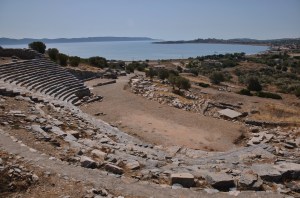
Looking over cavea and orchestra to Lavrio

The built end of the cavea
Epidauros
Arriving at Epidauros was a little more involved than arriving at Thorikos. For a start, Epidauros is one of the most famous historic sites in Greece, and it attracts hundreds of visitors a day, unlike Thorikos, which may possibly attract a visitor or two a week.
I simply looked into the opening time, and arrived ten minutes early, hoping to avoid a crowd. Arriving at 07:50, I found myself the third entrant (but the first Australian) of the day, and judging by the way things went, it was just as well.
I paid my 12€ and followed the Americans up the path. Just like at Thorikos, my heart skipped a beat when I glanced up and recognised the familiar cavea right in front of me.
For those unfamiliar with Epidauros, the theatre now here is important because it was built in the classical period, and was not significantly updated or rebuilt by the Romans. It is also one of the best preserved theatres of antiquity, providing us with probably the best indication of the way theatres were constructed in the classical period.
A group of puppies had followed the Americans and me up to the theatre and they gambolled as we explored.
As at Thorikos, I delivered Henry V’s prologue, though this time the theatron was not quite empty. The Americans seemed to appreciate my monologue more than the puppies, though. They had tried testing the theatre’s acoustics, but didn’t seem to recognise that they needed to project. Guidebooks seem to give tourists they impression that the cavea and the stone does all the work, but it’s obvious to any actor that you need to work with the space. I launched into my usual teacher voice, but found I needed to curtail my volume to reduce the echo. Truly amazing to hear your voice fill the space, and to hear it working two and a half thousand years after it was built. I do wonder what the presence of 12,000 audients might do to the acoustics, though.
I also managed to take a few shots of the place before the sun began to cast a shadow, and decided I would remain at the theatre until it was bathed in sunlight.
After looking through the museum (which is less than impressive due to the most significant artefacts being on display in Athens) and also the Askeplion, I returned to the theatre to sit in the shade and wait for the sun to cover the site. As soon as I sat in the auditorium, a group of young Germans passed, and a few minutes later they assembled on the orchestra, and sang three songs beautifully. The assembled tourists demanded an encore, and they gracefully obliged. I was halfway up the theatron, and my camera’s dodgy microphone actually caught the sound beautifully.
I returned to the theatre late in the day, as the sun was about to set unfortunately they close the site before sunset, so a real sunset photo is not possible for a mere commoner like me. And at any rate, I had a date with a moussaka I didn’t want to miss.
As I sat, I watched as several individuals got up and tested the acoustics. I enjoyed opera, people mindlessly yelling stupid things to their friends, a Frenchman who needed a lot of coaxing from an American he’d never met before he would stand and sing a little ditty, and a bit of hip hop, but the last was my favourite. Many of these tourists-come-performers took a little time to get comfortable but none so much as the last one of the day.
About twenty minutes before closing, I was left alone in the theatre. I enjoyed the silence, and started thinking about moussaka, as you do. As I made my way down towards the orchestra, a chap returned, who I had seen sitting alone and enjoying the performances just like me. He made a few tentative sounds by clicking his tongue, or clapping. As I passed the orchestra and moved towards the exit, I got the feeling he was waiting to have the theatre to himself. So of course, I let him think I’d left. I stood in a low position on the other side of the proskenion, where I was out of sight, and I took a few more snaps of the theatre.
As I did, he began to sing. He was nervous, even with the theatre empty, and he didn’t project especially well, but he warmed up. His wasn’t a voice you’d boast about, but he could hold a tune about as well as I could. And he gradually built in volume and had the theatron ringing.
I would hope that, in our own way, each of us would get a theatre ringing like that. That each of us would find a spot where we’re just pushing the boundaries of what’s comfortable. How many more smiles would we see if everyone just felt they could stand up and sing, however our voice sounds?

The approach to the theatre

One of the pups

Front row seats

Theatron, orchestra and proskenion
Next stop… the Theatre of Dionysius in Athens!
Athens
Okay, so by the time I arrive at the Theatre of Dionysius us in Athens, I’m feeling a little old-rock fatigue. Yes, even I get tired of seeing more and more ruins of ancient monuments. So I’m glad I allowed myself plenty of time here.
My first glimpse of the Theatre of Dionysius was from the Acropolis itself, looking down into the cavea and orchestra, and what remains of the Roman period skene, with the magnificently modern Acropolis Museum beyond. It’s a beautiful scene, but not heart-stopping like the previous two.
I think just knowing the alterations that have occurred to this site over the ancient period dampens my enthusiasm somewhat, as does the fact that the second and third teirs of the auditorium have been pillaged at some point. The theatre really doesn’t give a good account of itself, though this may be in part me now comparing it to other sites. It could also have something to do with the hubbub from the tourists here.
The Roman skene, thankfully, doesn’t just honour the emperor (Nero at the time), but also (and even predominantly) features Dionysius himself. The reliefs from the stage left end are beautifully preserved and evoke pathos across the years even without their colours.
And of course, just a few hundred metres away is the Roman Odeon of Herodes Atticus, which demonstrates that next stage of development in the architectural form, with much of its Roman stage intact. Unfortunately, the weather was not my friend and the performance I was hoping to see here was cancelled.

Theatre of Dionysius, from the Acropolis

The fancy seats added in the Hellenistic period
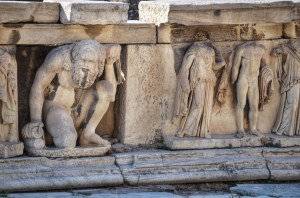
Reliefs from the Roman era stage

Throne of the Dionysian Priest
And so ends my pilgrimage. It’s been quite an adventure, and I would recommend it to other theatre nerds!

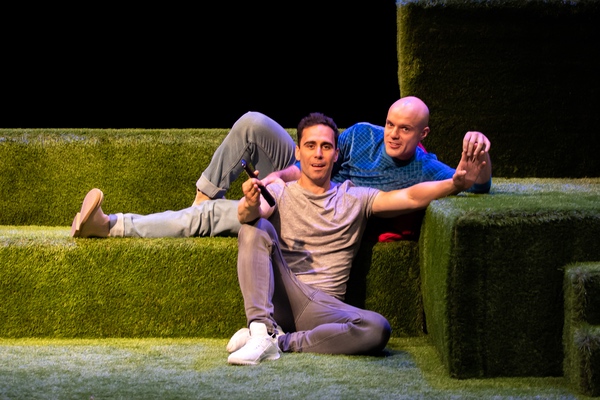
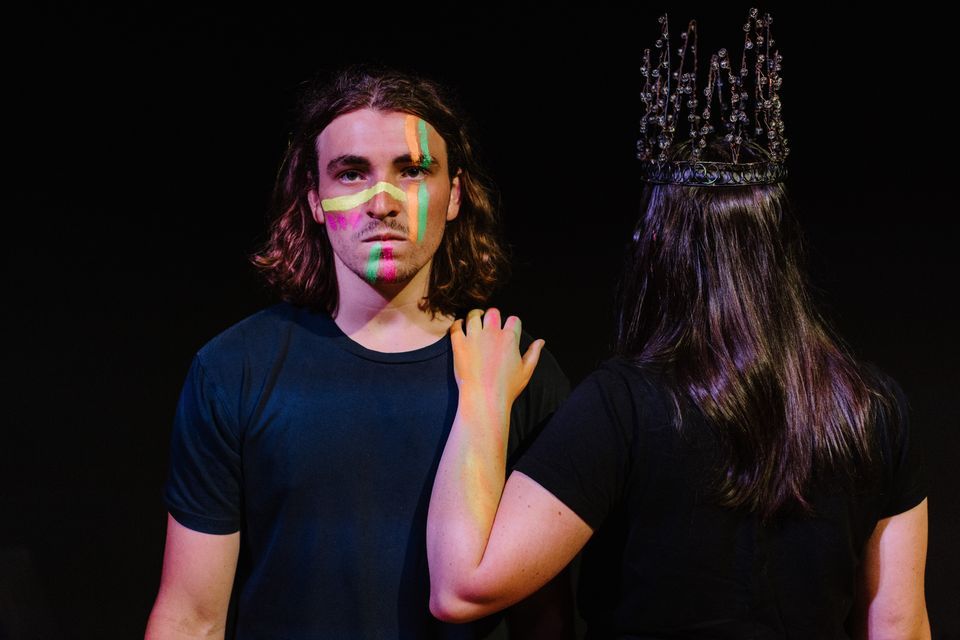
 Stumbling out of another theatre, again physically shaken by the performance I’ve just witnessed, I am awestruck by the ability of creatives to breathe new life into one of the oldest and most frequently redone stories in the canon. But this one was something extra special.
Stumbling out of another theatre, again physically shaken by the performance I’ve just witnessed, I am awestruck by the ability of creatives to breathe new life into one of the oldest and most frequently redone stories in the canon. But this one was something extra special.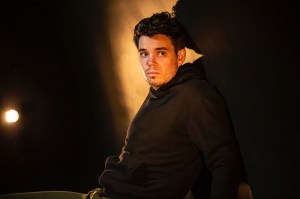 In Ripped, Gwyther portrays a male rape victim masking his trauma by taking action to fulfill a gender stereotype; a stereotype he struggles to define throughout. Gwyther also embodies the victim’s associates, and just keeping the plot clear is a challenge that he rises to with the deftest of hands.
In Ripped, Gwyther portrays a male rape victim masking his trauma by taking action to fulfill a gender stereotype; a stereotype he struggles to define throughout. Gwyther also embodies the victim’s associates, and just keeping the plot clear is a challenge that he rises to with the deftest of hands.
 In the light of the civil rights movements of the last five decades, the various ways to interpret the facts of Oscar Wilde’s life seem almost kaleidoscopic. Even in the two decades since David Hare wrote The Judas Kiss, our perspectives on queer rights have moved so dramatically that material of this age frequently jars current sensibilities. Perhaps because of its subject matter, but probably more because of Hare’s focus on the people he was writing about, the play doesn’t suffer from any such awkwardness.
In the light of the civil rights movements of the last five decades, the various ways to interpret the facts of Oscar Wilde’s life seem almost kaleidoscopic. Even in the two decades since David Hare wrote The Judas Kiss, our perspectives on queer rights have moved so dramatically that material of this age frequently jars current sensibilities. Perhaps because of its subject matter, but probably more because of Hare’s focus on the people he was writing about, the play doesn’t suffer from any such awkwardness. Landscapes and coastlines reminiscent of southern Australia give this film a grounded feel that exceeds most other depictions of biblical stories. Even the perspective lent to this story by looking at it through the eyes of Mary of Magdala puts me in mind of the strong and courageous women of the Australia Henry Lawson depicted.
Landscapes and coastlines reminiscent of southern Australia give this film a grounded feel that exceeds most other depictions of biblical stories. Even the perspective lent to this story by looking at it through the eyes of Mary of Magdala puts me in mind of the strong and courageous women of the Australia Henry Lawson depicted. Blood, as Stoppard’s tragedian says, is compulsory.
Blood, as Stoppard’s tragedian says, is compulsory. The greatest joy in visiting a fringe festival is being able to wander into a show with little to no awareness of what it’s about. Not every show turns out to be worth the time of day, but frequently they’re as good as Nightmare at 20,000 Feet.
The greatest joy in visiting a fringe festival is being able to wander into a show with little to no awareness of what it’s about. Not every show turns out to be worth the time of day, but frequently they’re as good as Nightmare at 20,000 Feet. Canberra’s sunsets are a little short for Shakespeare, but the timing was pretty damn near perfect for Shakespeare by the Lakes’ debut tonight.
Canberra’s sunsets are a little short for Shakespeare, but the timing was pretty damn near perfect for Shakespeare by the Lakes’ debut tonight. I don’t like slow. I’m pretty sure I don’t like slow. But this film is slow. And I liked it.
I don’t like slow. I’m pretty sure I don’t like slow. But this film is slow. And I liked it. Much of the publicity for Michael and Phillip are Getting Married in the Morning points to the December 2017 changes to the Marriage Act, which occurred between the writing of the play and its staging. Obviously the script was updated to reflect the changes, so I don’t think there really was a need to point them out. The publicity also bills it as a celebration of love, and although it does live up to this, there did seem to be some disagreement between the writer (who seems to have written a comedy) and the director (who seems to have directed a melodrama).
Much of the publicity for Michael and Phillip are Getting Married in the Morning points to the December 2017 changes to the Marriage Act, which occurred between the writing of the play and its staging. Obviously the script was updated to reflect the changes, so I don’t think there really was a need to point them out. The publicity also bills it as a celebration of love, and although it does live up to this, there did seem to be some disagreement between the writer (who seems to have written a comedy) and the director (who seems to have directed a melodrama).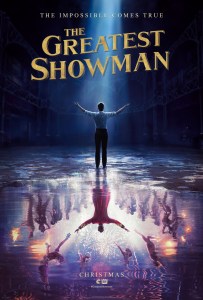 Rarely does a film come along that I can praise without reservation or qualification, but this is one. So much so that it’s barely worth writing about.
Rarely does a film come along that I can praise without reservation or qualification, but this is one. So much so that it’s barely worth writing about. First show back in Canberra, and I’m impressed. In a performance that would be right at home as part of the Edinburgh Fringe (oh, how I miss Fringe!), Canberra Youth Theatre present a series of stories that evoke a sense of what it means to be one’s self in the way we relate to others.
First show back in Canberra, and I’m impressed. In a performance that would be right at home as part of the Edinburgh Fringe (oh, how I miss Fringe!), Canberra Youth Theatre present a series of stories that evoke a sense of what it means to be one’s self in the way we relate to others.











 A little more theatrical than cabaret, but a little more cabaret than theatre, Royal Vauxhall straddles the divide exceptionally well, and presented beautifully in the pub it was named after.
A little more theatrical than cabaret, but a little more cabaret than theatre, Royal Vauxhall straddles the divide exceptionally well, and presented beautifully in the pub it was named after. Having recently produced a show that attempted to draw a bow through LGBTIQ history, I am familiar with the difficulty of having to eschew particular bits of history to get a story across. Outlaws to In-Laws navigates this dilemma quite well, I think.
Having recently produced a show that attempted to draw a bow through LGBTIQ history, I am familiar with the difficulty of having to eschew particular bits of history to get a story across. Outlaws to In-Laws navigates this dilemma quite well, I think. It might be being promoted as a “British Brokeback”, but apart from an agrarian context and some primal and near-violent sex scenes, God’s Own Country shares little in common with the groundbreaking American epic.
It might be being promoted as a “British Brokeback”, but apart from an agrarian context and some primal and near-violent sex scenes, God’s Own Country shares little in common with the groundbreaking American epic. Desperately running out of time to take in everything the Edinburgh Festival Fringe has to offer, I stumbled late into Banshee’s to see Rob Cawsey. Apparently he’s a comedian.
Desperately running out of time to take in everything the Edinburgh Festival Fringe has to offer, I stumbled late into Banshee’s to see Rob Cawsey. Apparently he’s a comedian.